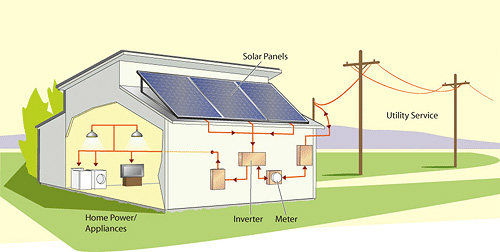Converting sunlight into electricity, and storing it or controlling the back feeding process to the grid is all part of what the main components of a solar photovoltaic system does.
The typical grid-tie system is the most common today.

A solar electric system has two main components: solar panels and an inverter. These components work together converting the sun’s energy into electrical power. The electrical power is then transferred through the inverter to power your home’s appliances and the utility service, spinning the meter backward. Credit: GreenPowerInstallers
Solar Panel:
Solar Panels are made of silicon and constitute a group of interconnected photovoltaic cells that directly convert light into Direct-Current (DC) electricity or energy at the atomic level, depending on the light incidence and without an external voltage source.
Inverter:
Appliances in a home run on Alternating Current (AC), but the solar panels produce DC current so there must be a conversion from DC to AC before this produced electricity can be used.
The inverter simply converts one type of voltage to another – in this case DC to AC.
Charge controller and battery:
With no sunlight at night, but with a higher energy demand for non-grid tied installations, some energy produced during the day can be stored in specially designed ‘Deep Cycle Batteries’ for later use.
The controller regulates the amount of energy flowing into a battery at a specific rate/time.
Electric Meter:
These are specially designed meters used in photovoltaic installations to help feed excess electricity to the grid.
Hope you enjoyed this review. If you did, let us know with a comment below and share some ideas of any such reviews you’d like covered.











Comments